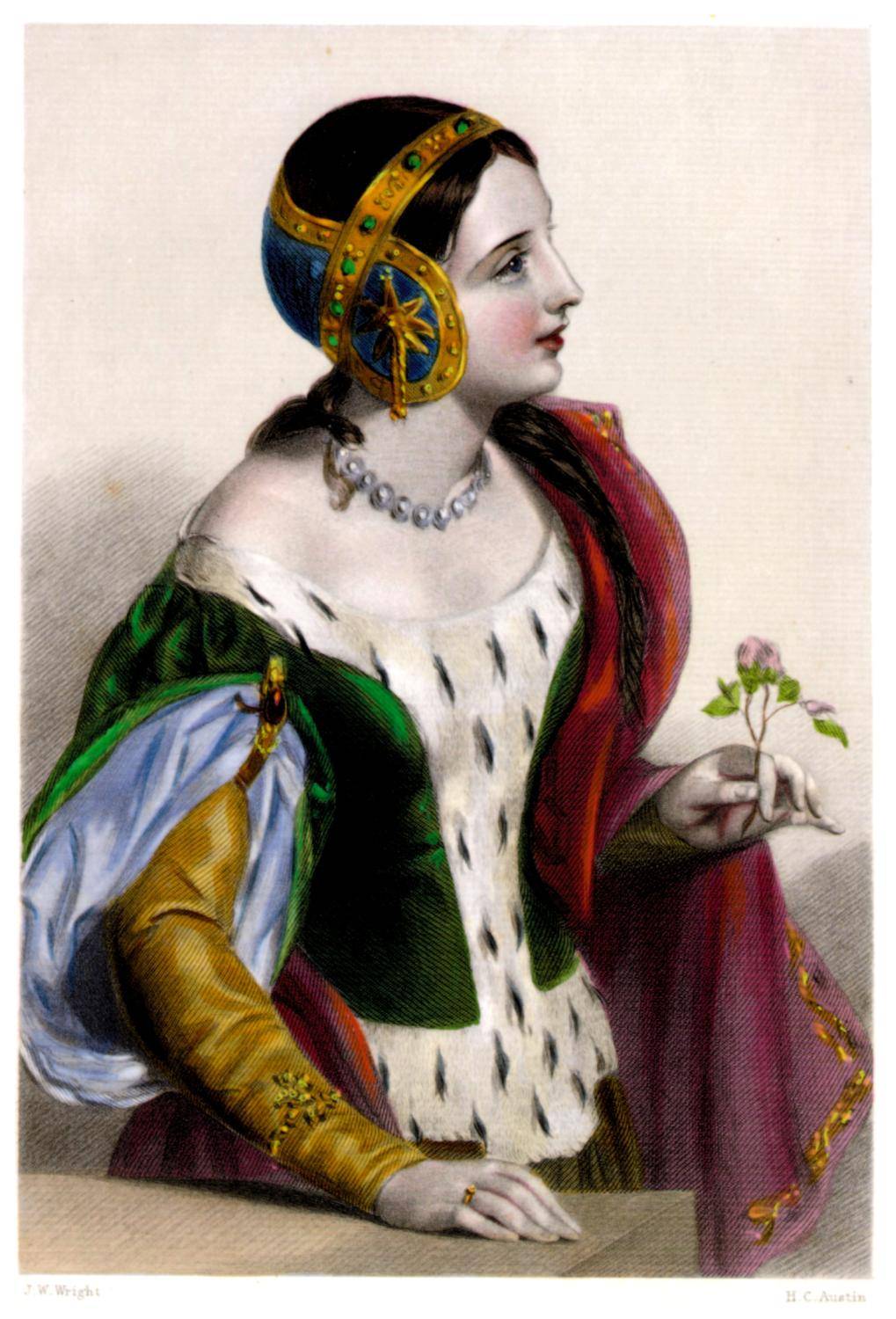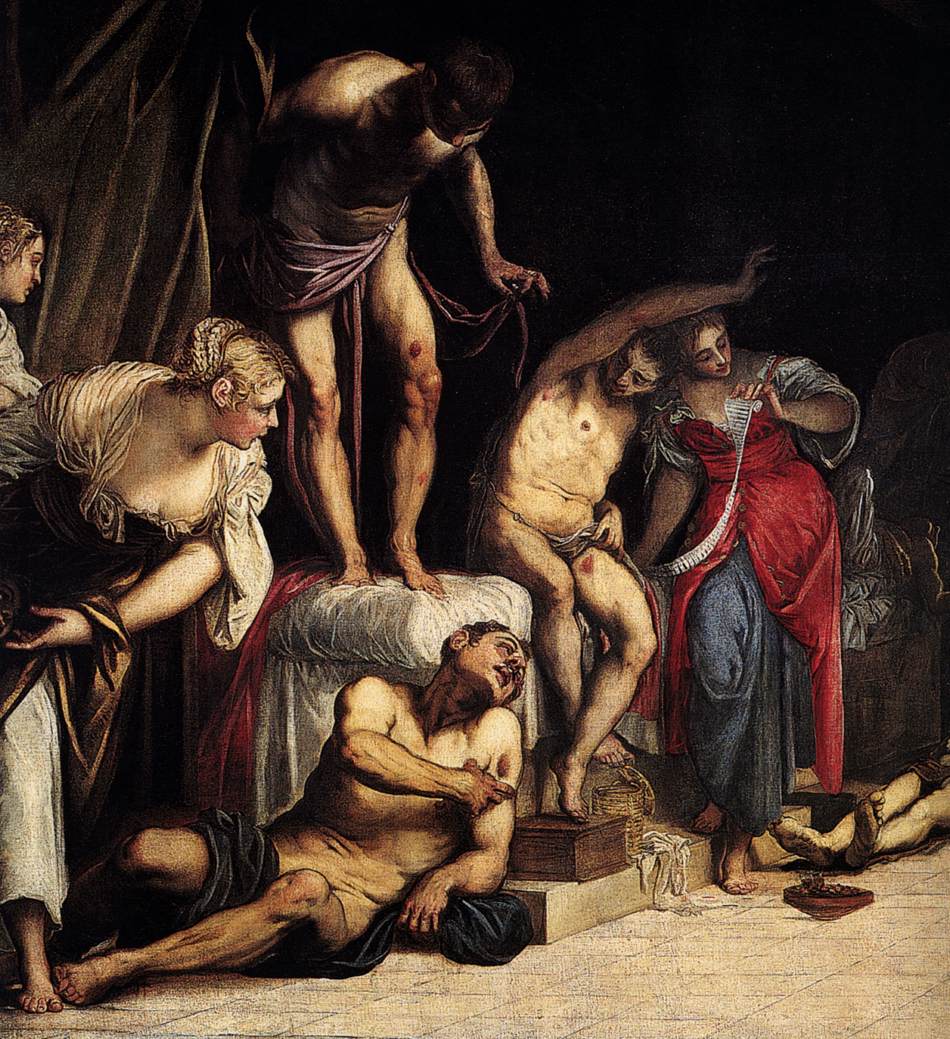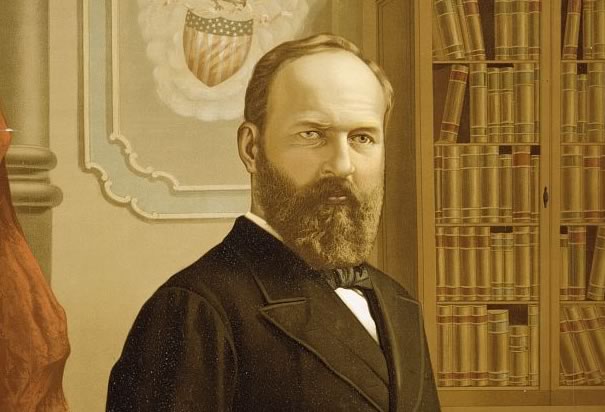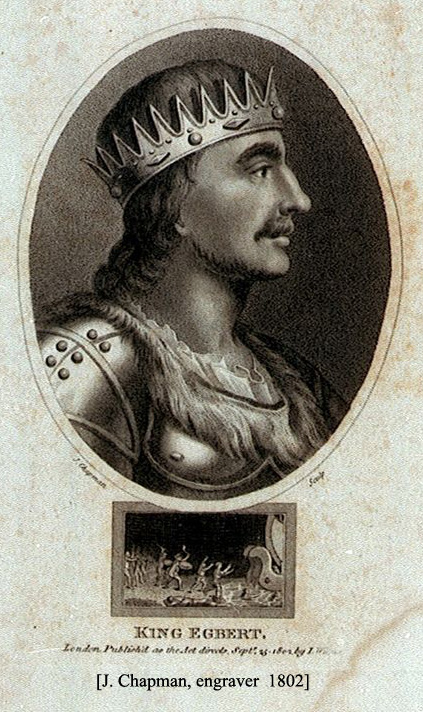Women married to the Plantagenet kings of England had quite different backgrounds. Here’s a list of these English queens, with basic information about each, and some linked to a more detailed biography:
1. Eleanor of Aquitaine (1122-1204)
Mother: Aenor de Châtellerault, daughter of Dangereuse, mistress of William IX of Aquitaine, by Aimeric I of Châtellerault
Father: William X, Duke of Aquitaine
Titles: was Duchess of Aquitaine in her own right; was Queen consort of France’s King Louis VII before they divorced and she married the future Henry II
Queen consort to: Henry II (1133-1189, ruled 1154-1189) — earlier Louis VII of France (1120-1180, ruled 1137-1180)
Married: Henry II May 18, 1152 (Louis VII in 1137, marriage annulled March 1152)
Coronation: (as Queen of England) December 19, 1154
Children: By Henry: William IX, Count of Poitiers; Henry, the Young King; Matilda, Duchess of Saxony; Richard I of England; Geoffrey II, Duke of Brittany; Eleanor, Queen of Castile; Joan, Queen of Sicily; John of England. (By Louis VII: Marie, Countess of Champagne, and Alix, Countess of Blois.)
Eleanor was Duchess of Aquitaine and Countess of Poitiers in her own right after the death of her father when she was 15. Married to then had her marriage annulled from the King of France after having two daughters, Eleanor married the future King of England. In their long marriage, she was, at different times, regent and prisoner, and she was involved in the struggles between her husband and sons. As a widow, she continued active involvement. Eleanor’s long life was filled with drama and many opportunities to exert power, as well as times when she was at the mercy of others. Eleanor’s life has attracted many historical and fictional treatments.
Eleanor of Aquitaine Biography:
Eleanor of Aquitaine, born in 1122, inherited the duchy of Aquitaine in April, 1137, from her father, William X of Aquitaine. Her mother was Aenor of Chatellerault, and she was named Al-Aenor or Eleanor after her mother.
In July 1137, just a few months after the death of her father, Eleanor of Aquitaine married Louis, heir to the throne of France. He became the King of France when his father died less than a month later.
During the course of her marriage to Louis, Eleanor of Aquitaine bore him two daughters, Marie and Alix. Eleanor, with an entourage of women, accompanied Louis and his army on the Second Crusade.
Rumors and legends abound as to the cause, but it’s clear that on the voyage to the Second Crusade, Louis and Eleanor drew apart. Their marriage failing — perhaps largely because there was no male heir — even the Pope’s intervention couldn’t heal the rift. He granted an annulment in March, 1152, on the grounds of consanguinity.
In May, 1152, Eleanor of Aquitaine married Henry Fitz-Empress, duke of Normandy through his mother and count of Anjou through his father, and heir to the throne of England as settlement of the conflicting claims of his mother Empress Matilda (Empress Maud), daughter of Henry I of England, and her cousin, Stephen, who had seized the throne of England at Henry I’s death. In 1154, Stephen died, making Henry II king of England, and Eleanor of Aquitaine his queen.
Eleanor of Aquitaine and Henry II had three daughters and five sons. Both sons who survived Henry became kings of England after him: Richard I (the Lionhearted) and John (known as Lackland).
In 1173, Henry’s sons rebelled against Henry, and Eleanor of Aquitaine supported her sons. Legend says that she did this in part as revenge for Henry’s adultery. Henry put down the rebellion and confined Eleanor from 1173 to 1183.
From 1185, Eleanor became more active in the ruling of Aquitaine. Henry II died in 1189 and Richard, thought to be Eleanor’s favorite among her sons, became king. From 1189-1204 Eleanor of Aquitaine also was active as a ruler in Poitou and Glascony. At the age of almost 70, Eleanor traveled over the Pyrenees to escort Berengaria of Navarre to Cyprus to be married to Richard.
When her son John joined forces with the King of France in rising against his brother King Richard, Eleanor backed Richard and helped bolster his rule when he was on crusade. In 1199 she supported John’s claim to the throne against her grandson Arthur of Brittany (Geoffrey’s son). Eleanor was 80 years old when she helped hold out against Arthur’s forces until John could arrive to defeat Arthur and his supporters. In 1204, John lost Normandy, but Eleanor’s European holdings remained secure.
Eleanor of Aquitaine died on April 1, 1204, at the abbey of Fontevrault, where she had visited many times and which she supported. She was buried in Fontevrault.
While legends persist that Eleanor presided over “courts of love” at Poitiers during her marriage to Henry II, there are no solid historical facts to back up such legends.
2. Margaret of France (1157 – 1197)
Mother: Constance of Castile
Father: Louis VII of France
Queen consort to: Henry the Young King (1155-1183; co-ruled as junior king with his father, Henry II, 1170-1183)
Married: November 2, 1160 (or August 27, 1172) Coronation: August 27, 1172
Children: William, died as an infant
Also married to: Bela III of Hungary
Married: 1186, widowed 1196
Her father was the former husband (Louis VII) of her husband’s mother (Eleanor of Aquitaine); her older half-sisters were thus also half-sisters of her husband.
3. Berengaria of Navarre (1163?-1230)
Mother: Blanche of Castile
Father: King Sancho IV of Navarre (Sancho the Wise)
Queen consort to: Richard I Lionheart (1157-1199, ruled 1189-1199)
Married: May 12, 1191
Coronation: May 12, 1191
Children: none
Richard is reported to have been engaged first to Alys of France, who was probably his father’s mistress. Berengaria joined Richard on crusade, accompanied by his mother, who was almost 70 years old at the time. Many believe that their marriage was not consummated, and Berengaria never visited England during her husband’s lifetime.
About Berengaria of Navarre:
Beregaria was the daughter of King Sancho VI of Navarre, called Sancho the wise, and Blanche of Castile.
Richard I of England had been betrothed to Princess Alice of France, sister of King Phillip IV. But Richard’s father, Henry II, had made Alice his mistress, and church rules therefore forbid the marriage of Alice and Richard.
Berengaria was chosen as wife to Richard I by Richard’s mother, Eleanor of Aquitaine. The marriage with Berengaria would bring a dowry that would help Richard finance his efforts in the Third Crusade.
Eleanor, though almost 70 years old, traveled over the Pyrenees to escort Berengaria to Sicily. In Sicily, Eleanor’s daughter and Richard’s sister, Joan of England, embarked with Berengaria to join Richard in the Holy Land.
But the ship carrying Joan and Berengaria was wrecked off the shore of Cyprus. The ruler, Isaac Comnenus, took them prisoner. Richard and part of his army landed in Cyprus to free them, and Isaac foolishly attacked. Richard freed his bride and his sister, defeated and captured Comnenus, and took control of Cyprus.
Berengaria and Richard were married on May 12, 1191, and set off together to Acre in Palestine. Berengaria left the Holy Land for Poitou, France, and when Richard was on his way back to Europe in 1192, he was captured and then held prisoner in Germany until 1194, when his mother arranged for his ransom.
Berengaria and Richard had no children. Richard is widely believed to have been a homosexual, and though he had at least one illegitimate child, it is believed that the marriage with Berengaria was little more than a formality. When he returned from captivity, their relationship was so bad that a priest went so far as to order Richard to reconcile with his wife.
After Richard’s death, Berengaria as dowager queen retired to LeMans in Maine. King John, Richard’s brother, seized much of her property and refused to repay her. Berengaria lived in virtual poverty during John’s lifetime. She sent to England to complain that her pension was not being paid. Eleanor and Pope Innocent III each intervened, but John never did pay her most of what was owed to her. John’s son, Henry III, finally did pay much of the overdue debts.
Berengaria died in 1230, soon after founding Pietas Dei at Espau, a Cistercian monastery.
4. Isabella of Angoulême (1188?-1246)
Also known as: Isabelle of Angoulême, Isabelle of Angouleme
Mother: Alice de Courtenay (King Louis VI of France was her mother’s grandfather)
Father: Aymar Taillefer, Count of Angoulême
Queen consort to: John of England (1166-1216, ruled 1199-1216)
Married: August 24, 1200 (John had his previous marriage to Isabel, Countess of Gloucester, annulled; they were married from 1189-1199).
Children: Henry III of England; Richard, Earl of Cornwall; Joan, Queen of Scots; Isabella, Holy Roman Empress; Eleanor, Countess of Pembroke.
Also married to: Hugh X of Lusignan (~1183 or 1195-1249)
Married: 1220
Children: nine, including Hugh XI of Lusignan; Aymer, Alice, William, Isabella.
John had beem married to Isabel (also known as Hawise, Joan or Eleanor), Countess of Gloucestor, in 1189, but had the childless marriage annulled before or shortly after he became king, and she was never queen. Isabella of Angouleme married John when she was twelve to fourteen (scholars disagree on her birth year). She was Countess of Angoulême in her own right from 1202. John also had a number of children by various mistresses. Isabella had been betrothed to Hugh X of Lusignan before her marriage to John. After she was widowed, she returned to her homeland and married Hugh XI.
Marriage to John of England:
Betrothed when very young to Hugh IX, Count of Lusignan, Isabella of Angouleme married John Lackland of England, son of Eleanor of Aquitaine and Henry II of England. John had put aside his first wife in 1198. Isabella was twelve years old at her marriage to John.
In 1202, Isabella’s father died, and Isabella became Countess of Angouleme in her own right.
The marriage of Isabella and John was not an easy one. John was infatuated with his young and beautiful wife, but they both were reported to have engaged in adultery, and to have had strong tempers which they used on each other. When John suspected Isabella of having had an affair, he had her suspected lover hanged and then dangled above her bed.
Isabella and John had five children before John died in 1216. At John’s death, Isabella’s quick action had her son Henry crowned at John’s death, in Gloucester where they were at the time.
Second Marriage:
Isabella of Angouleme returned to her homeland after John’s death. There she married Hugh X of Lusignan, son of the man she’d been betrothed to before marrying John, and the man who was betrothed to her eldest daughter by John. Hugh X and Isabella had nine children.
In 1244, Isabella was accused of conspiring against the French King to poison him, and she fled to the abbey at Fontevrault and hid for two years. She died in 1246, still hiding in the secret chamber. Hugh, her second husband, died three years later on crusade.
Burial:
Isabella had arranged to be buried outside the abbey at Fontevrault as penance, but some years after her death, her son, Henry III, King of England, had her re-interred beside her mother-in-law Eleanor of Aquitaine and father-in-law Henry II, inside the abbey.
Marriages:
- betrothed to: Hugh le Brun, Count of Lusignan
- married to: John I of England, August 24, 1200
- married to: Hugh X of Lusignan, Count of La Marche
Children of Queen Isabella of Angouleme and King John:
- King Henry III of England, born October 1, 1207
- Richard, Earl of Cornwall, King of the Romans
- Joan, married Alexander II of Scotland
- Isabella, married Emperor Frederick II
- Eleanor, married William Marshall and then Simon de Montfort
Children of Isabella of Angouleme and Hugh X of Lusignan, Count of La Marche:
- Hugh XI of Lusignan
- Aymer de Valence, a bishop
- Agnes de Lusignan, married William II de Chauvigny
- Alice le Brun de Lusignan, married John de Warenne
- Guy de Lusignan
- Geoffrey de Lusignan
- William de Valence
- Marguerite de Lusignan, married Raymond VII of Toulouse, then married Aimery IX de Thouars
- Isabele de Lusignan, married Geoffrey de Rancon
5. Eleanor of Provence (~1223-1291)
Mother: Beatrice of Savoy
Father: Ramon Berenguer V, Count of Provence
Sister to: Marguerite of Provence, Queen consort of Louis IX of France; Sanchia of Provence, Queen consort of Richard, Earl of Cornwall and King of the Romans; Beatrice of Provence, Queen consort of Charles I of Sicily
Queen consort to: Henry III (1207-1272, ruled 1216-1272)
Married: January 14, 1236
Coronation: January 14, 1236
Children: Edward I Longshanks of England; Margaret (married Alexander III of Scotland); Beatrice (married John II, Duke of Brittany); Edmund, 1st Earl of Leicester and Lancaster; Katharine (died at age 3).
Eleanor was very unpopular with her English subjects. She did not remarry after her husband’s death, but helped raise some of her grandchildren.
6. Eleanor of Castile (1241-1290)
Also known as: Leonor, Aleienor
Mother: Joan of Dammartin, Countess of Pointhieu
Father: Ferdinand, King of Castile and Leon
Grandmother: Eleanor of England
Title: Eleanor was Countess of Ponthieu in her own right
Queen consort to: Edward I Longshanks of England (1239-1307, ruled 1272-1307
Married: November 1, 1254
Coronation: August 19, 1274
Children: Sixteen, many of whom died in childhood. Surviving to adulthood: Eleanor, married Henry II of Bar; Joan of Acre, married to Gilbert de Clare and Ralph de Monthermer; Margaret, married John II of Brabant; Mary, Benedictine nun; Elizabeth, married John I of Holland, and Humphrey de Bohun; Edward II of England, born 1284.
Countess of Ponthieu from 1279. “Eleanor crosses” in England, three of which survive, were erected by Edward in his mourning for her.
7. Margaret of France (1279?-1318)
Also known as: Marguerite
Mother: Maria of Brabant
Father: Philip III of France
Queen consort to: Edward I Longshanks of England (1239-1307, ruled 1272-1307)
Married: September 8, 1299 (Edward was 60)
Coronation; never crowned
Children: Thomas of Brotherton, 1st Earl of Norfolk; Edmund of Woodstock, 1st Earl of Kent; Eleanor (died in childhood)
Edward had sent to France to marry Blanche of France, Margaret’s sister, but Blanche was already promised to another man. Edward was offered Margaret instead, who was about eleven years old. Edward refused, declared war on FranceFrance. After five years, he married her as part of the peace settlement. She never remarried after Edward’s death. Her younger son was the father of Joan of Kent.
8. Isabella of France (1292-1358)
Mother: Joan I of Navarre
Father: Philip IV of France
Queen consort to: Edward II of England (1284-1327?, ruled 1307, deposed 1327 by Isabella)
Married: January 25, 1308
Coronation: February 25, 1308
Children: Edward III of England; John, Earl of Cornwall; Eleanor, married Reinoud II of Guelders; Joan, married David II of Scotland
Isabella turned against her husband over his apparent affairs with several men; she was a lover of and fellow conspirator with Roger Mortimer in his rebellion against Edward II whom they deposed. Her son Edward III rebelled against Mortimer and Isabella’s rule, executing Mortimer and allowing Isabella to retire. Isabella was called the She-Wolf of France. Three of her brothers became King of France. England’s claim to the throne of France through Margaret’s lineage led to the Hundred Years War.
More About Isabella of France
Daughter of King Philip IV of France and of Jeanne of Navarre, Isabella was married to Edward II in 1308. Their son, the future Edward III, was born at the end of an English civil war. By the 1320s, Isabella and Edward II’s dislike of each other had escalated, as he spent more time with his favorites, including Piers Gaveston in what was almost certainly a homosexual affair. He supported one group of nobles, especially Hugh le Despenser the Younger (who may also have been Edward’s lover) and his family, and exiled or imprisoned others who then began to organize against Edward with the support of Charles IV (the Fair) of France, Isabella’s brother.
Isabella of France and Roger Mortimer
Isabella left England for France in 1325, and the next year she and her lover, Roger Mortimer, helped with efforts to invade England and depose Edward. Mortimer and Isabella had Edward II murdered in 1327, and Edward III was crowned king of England, with Isabella and Mortimer as his regents.
In 1330, Edward III decided to assert his own rule, escaping likely death. He executed Mortimer as a traitor and banished Isabella, forcing her to retire as a Poor Clare for more than a quarter century until her death.
More of Isabella’s Offspring
Isabella’s son John became Earl of Cornwall, her daughter Eleanor married Duke Rainald II of Gueldres and her daughter Joan (known as Joan of the Tower) married David II Bruce, King of Scotland.
When Charles IV of France died without a direct heir, his nephew Edward III of England claimed the throne of France through his descent through his mother Isabella, beginning the Hundred Years War.
9. Philippa of Hainault (1314-1369)
Mother: Joan of Valois, granddaughter of Philip III of France
Father: William I, Count of Hainault
Queen consort to: Edward III of England (1312-1377, ruled 1327-1377)
Married: January 24, 1328
Coronation: March 4, 1330
Children: Edward, Prince of Wales, known as The Black Prince; Isabella, married Enguerrand VII of Coucy; Lady Joan, died in the Black Death epidemnic of 1348; Lionel of Antwerp, Duke of Clarence; John of Gaunt, Duke of Lancaster; Edmund of Langley, Duke of York; Mary of Waltham, married John V of Brittany; Margaret, married John Hastings, Earl of Pembroke; Thomas of Woodstock, Duke of Gloucester; five died in infancy.
Her sister Margaret was married to Louis IV, Holy Roman Emperor. She was Countess of Hainault from 1345. A descendant of King Stephen and Matilda of Boulogne and of Harold II, she married Edward and was crowned during the time his mother, Isabella, and Roger Mortimer were acting as Edward’s regents. Philippa of Hainault and Edward III had an apparently close marriage. Queen’s College at Oxford is named for her.
10. Anne of Bohemia (1366-1394)
Also known as: Anne of Pomerania-Luxembourg
Mother: Elizabeth of Pomerania
Father: Charles IV, Holy Roman Emperor
Queen consort to: Richard II of England (1367-1400, ruled 1377-1400)
Married: January 22, 1382
Coronation: January 22, 1382
Children: no children
Her marriage came about as part of the papal schism, with support of Pope Urban VI. Anne, who was disliked by many in England and brought no dowry, died of the plague after twelve childless years of marriage.
11. Isabelle of Valois (1389-1409)
Also known as: Isabella of France, Isabella of Valois
Mother: Isabella of Bavaria-Ingolstadt
Father: Charles VI of France
Queen consort to: Richard II of England (1367-1400, ruled 1377-1399, deposed), son of Edward, the Black Prince
Married: October 31, 1396, widowed 1400 at age ten.
Coronation: January 8, 1397
Children: none
Also married to: Charles, Duke of Oreleans, 1406.
Children: Joan or Jeanne, married John II of Alençon
Isabelle was only six when she was married, as a political move, to Richard of England. Only ten when he died, they had no children. Her husband’s successor, Henry IV, tried to marry her to his son, who later became Henry V, but Isabelle refused. She remarried after returning to France, and died in childbirth at age 19. Her younger sister, Catherine of Valois, married Henry V.
Credit:
http://womenshistory.about.com/
© 2011 Clipart.com





















